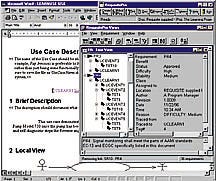Software Development Simplified with Requirements Management Tool
September 1, 1997
Software Development Simplified with
Requirements Management Tool
Improves the definition, management, and communication of project requirements
For medical device manufacturers, keeping track of FDA's increasingly complex and ever-changing design and manufacturing requirements can be a real challenge. As a result, they are seeking out tools that can help.

A developer of software for medical devices, Software Remodeling Inc. (SRI; Plano, TX), discovered such a tool. SRI is currently developing software, electronic, and mechanical subsystems for an infusion pump.
There are a variety of FDA guidelines and standard operating procedures that SRI must meet. Safety-critical requirements must be reviewed with extra scrutiny to ensure the code is accurate and the software is thoroughly tested. Testing the potential hazards of every device subsystem--software, electronic, or mechanical--is very important. For every potential failure mode, team members must perform a hazards analysis.
To help achieve this, SRI team leaders implemented RequisitePro--a requirements management tool developed by Boulder, CObased Rational Software--to improve the definition, management, and communication of project requirements throughout the development life cycle.
SRI's senior software engineer, Cecelia Rogers, is responsible for the definition of software requirements and the development of the software requirements specification (SRS). The SRS is a critical document because it describes exactly what the device needs to do to meet customer and safety requirements. The document also becomes part of the 510(k) submission to FDA.
SRI uses RequisitePro to trace all requirements that need to be tested and to specify how each requirement will be tested (i.e., by analysis or demonstration). Developers and testers can simply print out the hazards analyses and testing matrices for selected requirements and their attributes and include it with the 501(k) submission.
"One of the main benefits we have received from implementing RequisitePro," Rogers says, "is the ability to trace requirements from the highest-level specifications through software design documents and individual test plans. This traceability not only ensures that customer needs are met but also keeps us from implementing rogue requirements."
Prior to using RequisitePro, requirements were managed manually or with an in-house, proprietary system. Developers would have to export requirements data from a PC in a text file and then import them into a relational database--a time-consuming process. Additionally, a requirement change could not be traced or communicated effectively.
Because RequisitePro allows users to custom design fields and attributes within its requirements repository, SRI has created its own assignment field. Team leaders use this custom field to communicate responsibility for specific requirements to other members of the team, both inside and outside the SRI organization. "I can assign requirements to external project team members without having to generate a separate memo or E-mail. The assignment field tells people in real time what they should be working on," says Rogers. "When changes are made to the project documents or the requirements database, RequisitePro matrices bring attention to any conflicts. These flags have become a communication tool for us and have made us more productive," she explains.
"RequisitePro has greatly improved our project management process," notes SRI co-owner Jeff Rogers. "The tool helps us manage document releases and reports quickly and easily. What used to be a one- to two-hour job of manual processing is now a five-minute job with the click of a mouse."
For more information on Rational Software, call 303/444-3464.
You May Also Like


